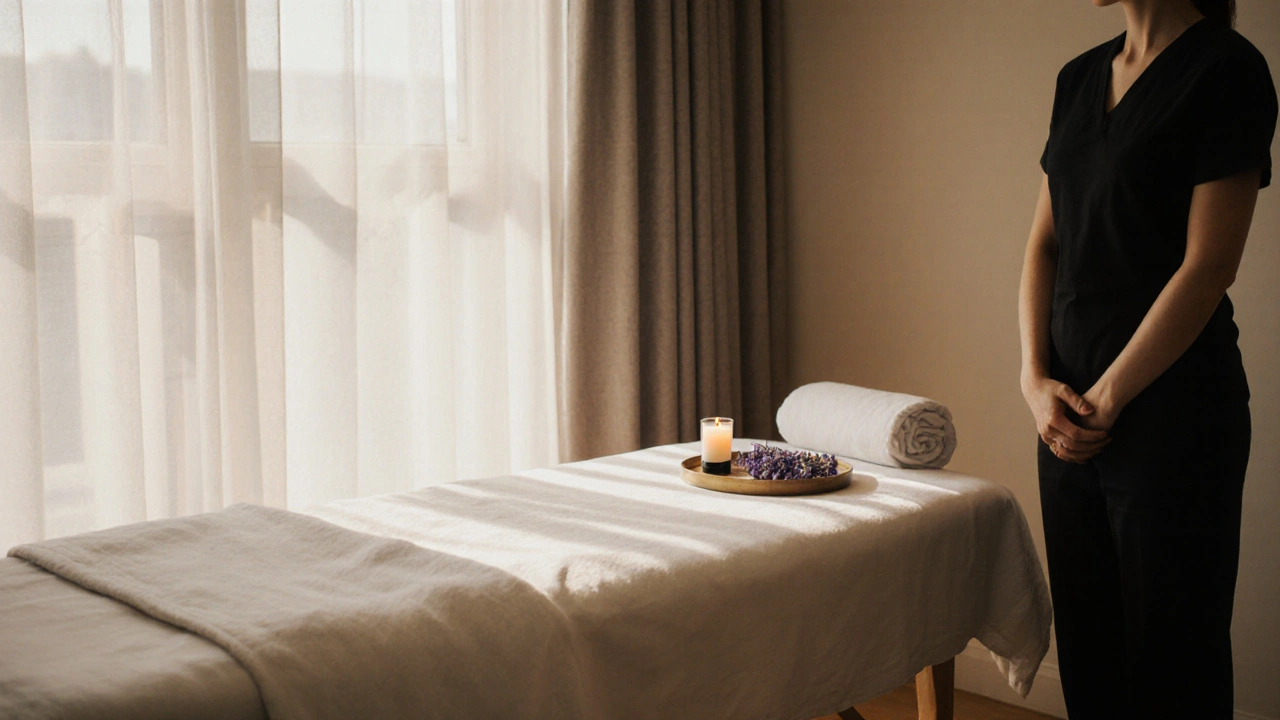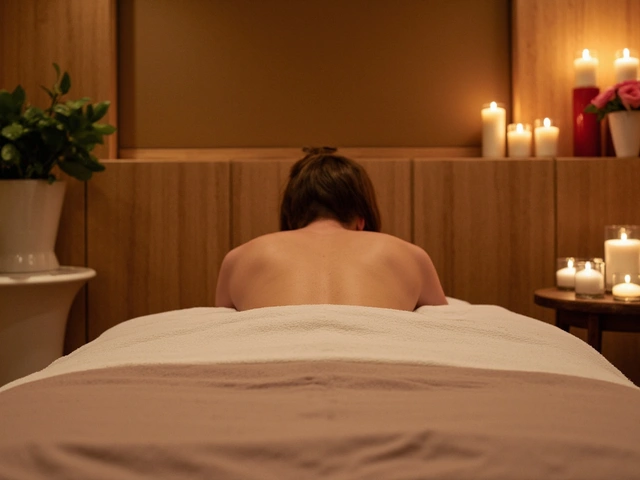You’ve probably felt it - that tight knot in your shoulder that won’t go away, no matter how much you stretch. Or the dull ache in your lower back after weeks of sitting at a desk. You’ve tried foam rollers, heat packs, even over-the-counter painkillers. But nothing gives you real, lasting relief. That’s where deep tissue massage comes in. It’s not just another spa treat. It’s a targeted, therapeutic tool that can break down stubborn tension, improve mobility, and help your body heal from the inside out.
What You Need to Know Right Away
- Deep tissue massage uses slow, firm pressure to reach deeper layers of muscle and connective tissue.
- It’s not about relaxation - it’s about correction. You might feel discomfort, but it should never be unbearable.
- Best for chronic pain, sports injuries, posture issues, and muscle stiffness from repetitive motion.
- One session won’t fix everything. Most people need 3-6 sessions for lasting results.
- Hydrate well before and after. Your muscles need water to flush out toxins released during the session.
What Is Deep Tissue Massage - And Why It’s Different
Think of your muscles like tangled ropes. Most massages - like Swedish - gently untangle the top layers. Deep tissue massage goes deeper. It targets the fascia, the thick connective tissue that wraps around your muscles, bones, and organs. When you sit all day, lift heavy things, or run hard, this fascia gets sticky. It binds down, restricts movement, and causes pain.
Deep tissue massage uses fingers, knuckles, elbows, and even forearms to apply focused pressure. The therapist doesn’t just rub - they work. They find the tight spots, hold pressure, and slowly release them. It’s like peeling back layers of tension that have built up over months or years.
This isn’t a luxury. It’s a recovery tool. Athletes use it. Office workers use it. People with arthritis, fibromyalgia, and old injuries use it. And it’s backed by science. A 2023 study in the Journal of Bodywork and Movement Therapies found that participants with chronic lower back pain saw a 40% reduction in pain intensity after six weekly deep tissue sessions.
Why Deep Tissue Massage Works - Real Benefits
Let’s get practical. What does this actually do for you?
- Breaks down scar tissue - After an injury, your body lays down fibrous tissue to heal. That tissue can be stiff and painful. Deep tissue massage helps realign it.
- Improves circulation - Better blood flow means more oxygen and nutrients reach your muscles. That speeds up recovery and reduces soreness.
- Reduces inflammation - Chronic pain often comes with low-grade inflammation. Deep pressure helps calm the nervous system’s pain signals.
- Corrects posture - If your shoulders hunch forward from typing, your chest muscles tighten. Your upper back muscles weaken. Deep tissue can loosen the tight ones and re-engage the weak ones.
- Helps with headaches - Tension headaches? Often caused by tight neck and upper back muscles. A focused session on those areas can cut headache frequency in half.
One client I worked with in Birmingham - a graphic designer who’d had migraines for 8 years - went from 3-4 headaches a week to one every three weeks after just four sessions. She didn’t even need her painkillers anymore.
Types of Deep Tissue Techniques Used in the UK
Not all deep tissue is the same. Therapists use different styles depending on your needs.
- Myofascial Release - Focuses on the fascia. Uses sustained pressure and slow stretches. Great for stiffness that moves around your body.
- Trigger Point Therapy - Targets specific knots (trigger points) that refer pain to other areas. Like a knot in your shoulder causing pain down your arm.
- Sports Deep Tissue - Tailored for athletes. Combines deep pressure with active movement. Often used before or after training.
- Chronic Pain Protocol - Slower, gentler, with more breaks. Designed for people with conditions like fibromyalgia or arthritis.
In the UK, most clinics offer variations of these. Don’t assume all “deep tissue” is the same. Ask your therapist what technique they use and why.

How to Find a Good Deep Tissue Massage Therapist Near You
Not every massage therapist knows how to do deep tissue right. Some just press harder and call it deep tissue. That’s not therapy - that’s pain.
Here’s how to find someone who actually knows what they’re doing:
- Look for certifications - Level 3 Diploma in Massage Therapy or ITEC/VTCT with a focus on remedial or sports massage.
- Check reviews - Look for mentions of “chronic pain,” “posture,” or “injury recovery.” Avoid places that only mention “relaxation” or “romantic vibe.”
- Ask about experience - “How many clients with lower back pain have you helped?” A good therapist will have specific examples.
- Visit in person - A good therapist will talk to you before the session. They’ll ask about your pain, lifestyle, and goals. If they just hand you a form and shut the door, walk out.
In Birmingham, clinics in Edgbaston, Moseley, and the city centre often have well-trained therapists. Look for places that list “remedial massage” or “musculoskeletal therapy” on their website.
What Happens During a Session - Step by Step
First-time clients often worry it’ll be too painful. Here’s what you can actually expect:
- Consultation (5-10 minutes) - The therapist asks about your pain, injuries, and goals. Be honest. Don’t say “I’m fine” if you’re in constant discomfort.
- Preparation - You’ll undress to your comfort level (usually underwear or shorts). You’ll be covered with a towel at all times.
- The massage (45-75 minutes) - The therapist starts with lighter strokes to warm up the tissue. Then they go deeper. You might feel pressure, heat, or even a burning sensation - but it should feel like “good pain.” If it’s sharp, numb, or unbearable, speak up.
- Aftercare - They’ll give you stretches to do at home and tell you to drink water. You might feel sore for 24-48 hours. That’s normal.
Pro tip: Breathe. When the pressure gets intense, holding your breath makes you tenser. Exhale slowly. It helps the muscle let go.
How Much Does It Cost? What You’ll Pay in the UK
Prices vary by location and experience.
- £50-£70 for a 60-minute session in most UK cities.
- £75-£100 for 90-minute sessions or therapists with advanced certifications.
- £40-£55 for mobile therapists (they come to you).
Some clinics offer packages - 5 sessions for £250, for example. That’s usually cheaper than paying per session. If you’re dealing with chronic pain, a package makes sense.
Insurance? Some private health plans (like Bupa or AXA) cover remedial massage if it’s prescribed by a GP or physio. Ask your provider.

Safety First - Who Should Avoid Deep Tissue Massage
It’s powerful - but not for everyone.
Avoid it if you have:
- Recent injuries (fractures, sprains, or surgery in the last 6-8 weeks)
- Blood clots or deep vein thrombosis (DVT)
- Severe osteoporosis
- Open wounds, infections, or skin conditions
- Advanced cancer (unless cleared by your oncologist)
- Pregnancy (unless done by a certified prenatal therapist)
If you’re on blood thinners, tell your therapist. They’ll adjust the pressure. Never lie about your health. It’s not just about safety - it’s about getting the right treatment.
Deep Tissue vs. Sports Massage - Which Is Right for You?
| Feature | Deep Tissue Massage | Sports Massage |
|---|---|---|
| Primary Goal | Release chronic tension, break down scar tissue | Improve performance, prevent injury, aid recovery |
| Pressure | Consistently firm and slow | Varies - can be deep or light, often with movement |
| Best For | Office workers, chronic pain, posture issues | Athletes, runners, gym-goers, active people |
| Session Length | 60-90 minutes | 30-75 minutes |
| After Effects | Soreness for 1-2 days | Usually less sore, more energized |
| Frequency | Once every 2-4 weeks for maintenance | Weekly during training, biweekly off-season |
If you’re not an athlete but you sit at a desk all day? Go with deep tissue. If you train hard and want to recover faster? Sports massage might be better. Some people do both - deep tissue to fix the problem, sports massage to keep it from coming back.
Frequently Asked Questions
Does deep tissue massage hurt?
It shouldn’t hurt - but it can feel intense. Think of it like a good stretch. You feel pressure, maybe a burn, but it’s manageable. If it’s sharp, shooting, or makes you gasp, tell your therapist. They’ll ease up. Pain isn’t progress - it’s a warning.
How many sessions do I need?
One session might feel great, but real change takes time. For chronic pain or long-term tension, aim for 3-6 weekly sessions. Then, switch to maintenance - once every 3-4 weeks. Think of it like going to the gym. One workout won’t transform your body. Consistency does.
Can I get deep tissue massage if I’m pregnant?
Only if you see a therapist trained in prenatal massage. Standard deep tissue is too intense for pregnancy. But a skilled prenatal therapist can use modified techniques to ease lower back pain, reduce swelling, and improve sleep - safely.
Why do I feel tired after a session?
You’re not broken - you’re healing. Deep tissue massage releases stored toxins and resets your nervous system. That can make you feel drained, even sleepy. Drink water, rest, and avoid intense exercise for 24 hours. You’ll feel better the next day.
Is deep tissue massage better than physiotherapy?
They’re different tools. Physiotherapy focuses on movement, strength, and rehab exercises. Deep tissue massage releases muscle tension that blocks movement. Many people do both - massage loosens the tight muscles, then physio helps you rebuild strength correctly. One doesn’t replace the other; they work together.
Ready to Feel Better?
If you’ve been living with tight shoulders, aching back, or stiff hips - you don’t have to accept it as normal. Deep tissue massage isn’t magic. But it’s one of the most effective, natural ways to reclaim your body. Start with one session. See how you feel. Then decide if it’s the tool you’ve been missing.
Book your first session this week. Your future self will thank you.









Kyle Levy
November 1, 2025 AT 02:36Let me just say this: if you think deep tissue massage is just 'pressing harder,' you've been scammed by spa marketing. Real deep tissue isn't about brute force-it's anatomical precision. You need to understand fascial planes, myofascial trigger points, and neuromuscular inhibition. Most 'therapists' are just strong people with a certificate. I've studied kinesiology for eight years, and I can tell you-this article is half-right. Hydration helps, sure, but lymphatic drainage protocols matter more. And no, it doesn't 'break down scar tissue'-that's pseudoscience. Scar tissue remodels over time with controlled stress, not pressure. Please stop spreading misinformation.
Kevin Poston
November 1, 2025 AT 03:33Hey, I just wanted to say thank you for writing this. I’ve had chronic lower back pain for years, and after six sessions, I actually slept through the night for the first time in a decade. I was skeptical too-thought it was just a fancy way to get rubbed down. But the therapist I found in Portland? She asked about my work posture, my sleep habits, even my stress levels. It felt like she cared. I’m not saying it’s magic, but it’s the closest thing I’ve found to real relief. Keep sharing this stuff. People need to know it’s possible to feel better.
Scott Randall
November 1, 2025 AT 13:48It’s 'deep-tissue massage,' not 'deep tissue massage.' Hyphenated compound modifier. Also, 'fascia' is singular, not plural. And 'posture issues' is correct, not 'posture issue.' Just saying.
Thiago Gonçalves
November 2, 2025 AT 16:11This is actually life-changing info. 😊 I used to think massage was just for relaxation, but after my shoulder injury last year, my PT recommended deep tissue. First session? Felt like someone was digging through my muscles with a crowbar. Second? Barely recognizable. Now I go every 3 weeks like clockwork. I even started doing the stretches they showed me-no more waking up like a rusty robot. You’re right: it’s not a luxury. It’s maintenance. Thanks for the clarity!
Tim Orrell
November 3, 2025 AT 15:24The neurophysiological modulation of nociceptive pathways via mechanoreceptor stimulation under sustained pressure is a well-documented phenomenon in manual therapy literature. The concept of fascial adhesion as a primary etiological factor in chronic myofascial pain remains contested among biomechanical researchers. That said, the autonomic nervous system recalibration observed post-treatment correlates with reduced sympathetic tone and increased vagal activity. Ergo, the subjective experience of relief may be less about tissue restructuring and more about central sensitization attenuation. Also hydrate. Always hydrate.
Clay Caldwell
November 3, 2025 AT 17:33In India, we have something called 'dabba massage'-old guys with calloused hands using coconut oil and bare elbows. No certification, no clinic, just a chair in the alley. They don't call it deep tissue. They just fix you. I've seen men in their 70s walk out of there like they're 30. Maybe the real lesson isn't in the technique, but in the intention. Pressure doesn't need a diploma. It just needs to be consistent.
anjan tiwari
November 5, 2025 AT 13:33Bro this is just expensive stretching. I tried it. Felt like getting kicked by a donkey. Still have back pain. Also why is everyone in the UK paying £70? We pay ₹500 (~$6) here and the guy uses his feet. 😂